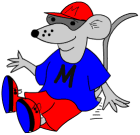 On this free maths worksheet is some pretty hard work concerned with prisms.
On this free maths worksheet is some pretty hard work concerned with prisms.
(A prism is a solid figure whose bases or ends have the same size and shape and are parallel to one another, and each of whose sides is a parallelogram.)
It is a good idea to try and collect a variety of prisms so that there properties can be explored in detail.
Look out for interesting shaped boxes eg toblerone packet is a triangular prism.
There are some interesting facts about prisms such as the number of faces is always two more than the number of edges on the end. Other facts are included on the answer page.
Free Y4 maths worksheet: More about prisms
 The last in this particular sequence of type of question, once again concentrating on place value and the knowledge that addition and subtraction are inverse.
The last in this particular sequence of type of question, once again concentrating on place value and the knowledge that addition and subtraction are inverse. Continuing with our numbers word searches this looks at numbers mainly in the whole tens. Quite tricky as there are so many ‘ty’s in the wordsearch!
Continuing with our numbers word searches this looks at numbers mainly in the whole tens. Quite tricky as there are so many ‘ty’s in the wordsearch! On this free maths worksheet is some pretty hard work concerned with prisms.
On this free maths worksheet is some pretty hard work concerned with prisms.